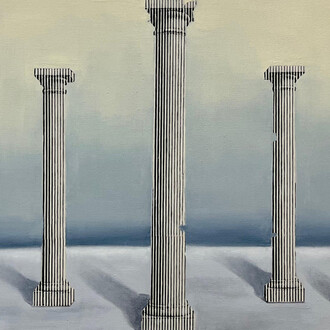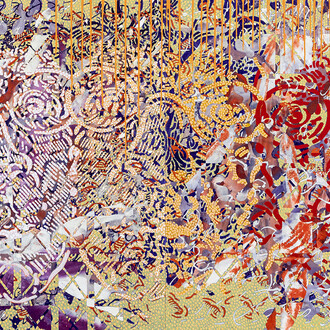"It is possible that the question of painting is only the question of the fold," wrote Simon Hantaï, whose work explored the potential of folding with a fertile radicality.
As a dense year draws to a close, Ceysson & Bénétière dedicates the summer exhibition of its Paris gallery to this notion—at once visual, conceptual, and poetic: the fold, and by extension, the drape. Ten artists of different generations have been brought together to reflect the extraordinary polysemy of this ancestral motif.
A portion of material folded back on itself, creating a ripple or a trace, the fabric fold appears as a visual trap that structures the composition of a work. At times a support, at times a material, it also becomes a pretext for formal exploration, allowing the artist to display virtuosity through the illusion of volume—whether pictorial or sculptural.
The artists gathered in this exhibition embody the manifold plastic potentialities of the fold and drape, both in their illusionistic dimension and their tangible, three-dimensional presence. In their works, the fold is first intimately linked to the representation of the body—through the mediums of drawing and photography—before gradually detaching itself to become the central protagonist of the artwork. It bears, whether physically or metaphorically, the imprint of the creative gesture, reflecting a living dialogue between material, form, and the memory of the body rendered in negative.
One first thinks of the classical drape, which, from the Renaissance onward, emerged as a subject of study and a test of formal virtuosity, but also as a vehicle of affect in service of what Alberti called the Historia. For Jean-Luc Verna, drawing is far from a mere preparatory exercise: it is the backbone of his entire practice. With a precise and controlled gesture, the artist subverts academic codes, transforming drawing into a space of transgression.
The dramatic tension of the drape takes on a spiritual, even mystical dimension in mounir fatmi’s reinterpretation of Michelangelo’s Pietà. Composed of electrical cables, the Virgin as mater dolorosa evokes both human communication and that between the earthly and the divine. The dynamism of the drapery guides the gaze in a dramatic rhetorical flow.
Much like Corradini’s Allegory of modesty (1752), the artist paradoxically covers flesh only to reveal it all the more in the suggestion of desire. This is the very tension taken up by Orlan in her reinterpretation of Ingres’ Grande odalisque, where fabric becomes the vector of a reflection on gender stereotypes, feminine attributes, and imagery inherited from art history. The dowry sheets, the material of this living work, carry within them an intimate and critical narrative, at the crossroads of personal history and Western visual heritage.
Drawn close to the body until it merges with it, the fold ultimately replaces it, then evokes its actions metaphorically. In this approach, the fold signifies an absence: it embodies a body without showing it, like a metonymic imprint. Cast in metal, Wilfrid Almendra’s hyperrealistic dirty socks freeze a fragment of daily life, encapsulated in a suspended moment. Through this “false soft,” the artist blurs perceptual cues while cleverly subverting traditional ideals of Beauty and the academic legacy of the drape.
From the 1970s onward, artists of the Supports/Surfaces movement incorporated the operation of folding into their broader effort to deconstruct painting, extending the inquiries initiated by Simon Hantaï, whose foldings had profoundly renewed the relationship to gesture and pictorial surface. In Patrick Saytour’s work, the body invests the entire surface of the canvas through folding, almost matching his own wingspan. The folded, then unfolded canvas captures the marks of movement, making the rudimentary process of creation visibly present.
A modest material used on house-painting sites, cheesecloth (tarlatane) has accompanied Noël Dolla’s work since 1969. Dyed through successive soakings with drying phases in between, the material follows its own logic—being folded, unfolded, and refolded. The layers of color align into a painting devoid of narration or sentiment, where intention yields to action. His former student, David Raffini, carries this thinking forward in his series Brumes et ondoiements, where each unstretched canvas bears the memory of a gesture. The painted fabric becomes an abstract landscape inhabited by the artist’s sensory presence and the inflections of a body whose impact it retains. Here, the fold transforms the surface into an object through the illusion of three-dimensionality, despite its actual flatness.
For Aurélie Pétrel, the drape becomes the very subject of the work through a simple close-up photograph of an abandoned cinema curtain. Removed from its original, unknown context, the photographed fold is reassembled in the exhibition space. It functions simultaneously as a self-referential, abstract image and a narrative trigger, a symbol of fiction yet to come.
Thus, the fold reveals itself as the sensitive embodiment of bodily expressivity, opening a space for spontaneity and chance that distinguishes it from the academic drape. At first closely tied to the representation of the human figure, it gradually emancipates itself, retaining only the trace of gestures—until it becomes autonomous, a true subject in its own right.
(Text by Mara Di Maggio)



![Aurélie Pétrel, 1962 [verre] - 28 avril minuit chez Roland, 2022. Courtesy of Ceysson & Bénétière](http://media.meer.com/attachments/e08448a359f7e0e4c69c8f051d2310c429b5c6cf/store/fill/410/615/81db4e417901c4b466454df04fa74e5782037236732f8b611a031b891133/Aurelie-Petrel-1962-verre-28-avril-minuit-chez-Roland-2022-Courtesy-of-Ceysson-and-Benetiere.jpg)











